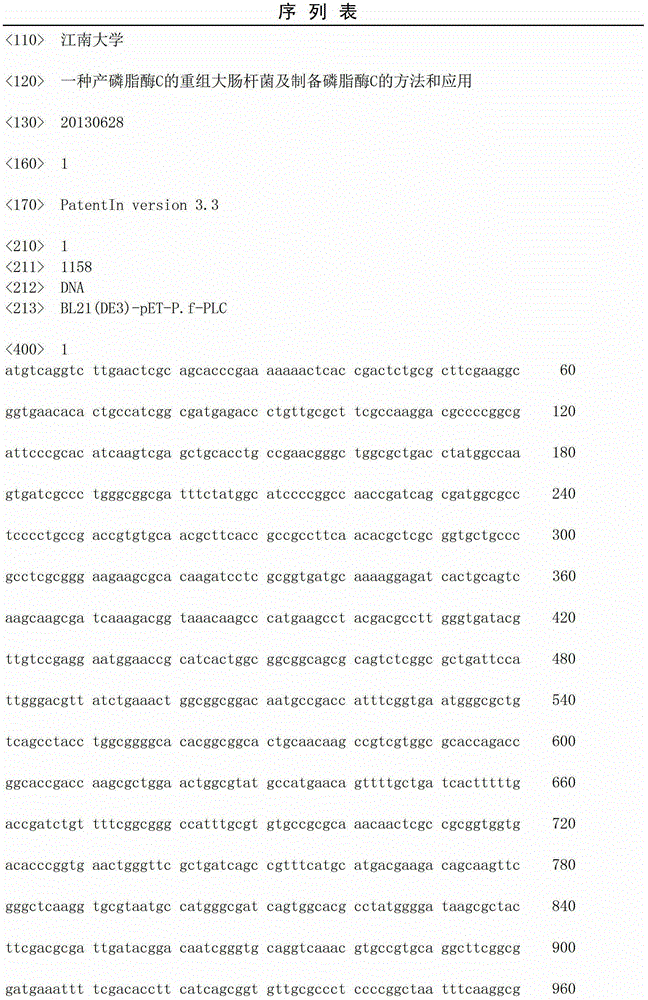A kind of recombinant escherichia coli producing phospholipase c and the method and application of preparing phospholipase c
A technology for recombining Escherichia coli and phospholipase, which is applied in the field of bioengineering, can solve the problems of high cost of separation and purification, environmental pollution by waste water and saponin, and short production cycle, and achieves simple production process, easy process amplification, and high enzyme yield. Effect
- Summary
- Abstract
- Description
- Claims
- Application Information
AI Technical Summary
Problems solved by technology
Method used
Image
Examples
Embodiment 1
[0039] Cloning of embodiment 1 phospholipase C gene
[0040] According to the sequence design primer of the phospholipase C gene (NC_017911.1) of PseudomonasfluorescensA506 provided on NCBI, wherein,
[0041] Upstream primer 5'CG GAATTC ATGTCAGGTCTTGAACTCGC3', (the underline is the EcoRI restriction site); downstream primer 5'TT GCGGCCGC TTAGTTGGCGGGTTGGTTTGGC3', (the underline is the NotI restriction site).
[0042] Using the genomic DNA of Pseudomonas fluorescens (Pseudomonas fluorescens) with the preservation number CCTCCNo.M2013298 as a template, the phospholipase C gene was cloned by PCR, and connected with the vector pMD18T-simple to construct the cloning vector pMD-plc, the clone The vector was transformed into Escherichia coli competent cell E.coliJM109, and positive clones were selected and verified by sequencing. The base sequence thereof was shown in SEQ ID NO: 1, and the result indicated that the phospholipase C gene was successfully cloned. Blast sequence comp...
Embodiment 2
[0043] Construction of embodiment 2 plasmid pET-P.f-PLC
[0044] Digest the recombinant vector pMD-plc and the expression vector pET-28a(+) with EcoRI and NotI. The digestion reaction system is 10 μL: pET-28a(+) μL, 0.5 μL each of EcoRI and NotI, shared by EcoRI and NotI Buffer1μL. The target gene and carrier DNA were recovered and ligated with T4 DNA ligase. The ligation reaction system was 10 μL: 5 μL of target gene, 3 μL of carrier DNA, 10×T4 ligase buffer 1 μL, T4 DNA ligase 1 μL, and reacted at 16°C for 12 hours.
[0045] Transform the ligation product into Escherichia coli competent cells E.coliJM109, the transformation method is as follows:
[0046] (1) Take 100 μL of E.coliJM109 and place it in a sterile 1.5ml EP tube;
[0047] (2) Add the above ligation product and mix gently;
[0048] (3) Put the above-mentioned EP tube in a constant temperature water bath at 42°C, time it for 1.5 minutes, and do not shake the EP tube;
[0049] (4) Transfer the EP tube to an ice ...
Embodiment 3
[0053] Example 3 Construction of Recombinant Escherichia coli Escherichiacoil BL21(DE3)-pET-P.f-PLC, CCTCCNo.M2013299
[0054] The constructed recombinant plasmid pET-plc was transformed into Escherichia coli BL21(DE3), and the transformation method was as follows:
[0055] (1) Take 100 μL of E.coliBL21(DE3) and place it in a sterile 1.5ml EP tube;
[0056] (2) Add the above-mentioned recombinant plasmid pET-plc and mix gently;
[0057] (3) Place the above EP tube in a constant temperature water bath at 42°C, accurately time it for 1.5 minutes, and do not shake the EP tube;
[0058] (4) Transfer the EP tube to an ice bath and cool for 2 minutes;
[0059] (5) Add 800 μL of sterile LB medium to each tube, and place in a 37°C incubator for recovery for 1 hour;
[0060] (6) Centrifuge at 8000r / min for 2min, suck off 800μL of supernatant medium, gently blow and suck the remaining medium and cells with a pipette gun, and transfer to LB solid plate with a final concentration of 10...
PUM
| Property | Measurement | Unit |
|---|---|---|
| diameter | aaaaa | aaaaa |
Abstract
Description
Claims
Application Information
 Login to View More
Login to View More - R&D
- Intellectual Property
- Life Sciences
- Materials
- Tech Scout
- Unparalleled Data Quality
- Higher Quality Content
- 60% Fewer Hallucinations
Browse by: Latest US Patents, China's latest patents, Technical Efficacy Thesaurus, Application Domain, Technology Topic, Popular Technical Reports.
© 2025 PatSnap. All rights reserved.Legal|Privacy policy|Modern Slavery Act Transparency Statement|Sitemap|About US| Contact US: help@patsnap.com


